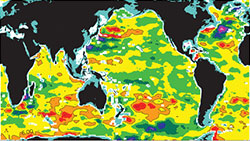For decades, the earth’s oceans have soaked up more than nine-tenths of the atmosphere’s excess heat trapped by greenhouse gas emissions. By stowing that extra energy in their depths, oceans have spared the planet from feeling the full effects of humanity’s carbon overindulgence.
But as those gases build in the air, an energy overload is rising below the waves. A raft of recent research finds that the ocean has been heating faster and deeper than scientists had previously thought. And there are new signs that the oceans might be starting to release some of that pent-up thermal energy, which could contribute to significant global temperature increases in the coming years.

The ocean has been heating at a rate of around 0.5 to 1 watt of energy per square meter over the past decade, amassing more than 2 X 1023 joules of energy — the equivalent of roughly five Hiroshima bombs exploding every second — since 1990. Vast and slow to change temperature, the oceans have a huge capacity to sequester heat, especially the deep ocean, which is playing an increasingly large uptake and storage role.
That is a major reason the planet’s surface temperatures have risen less than expected in the past dozen or so years, given the large greenhouse gas hike during the same period, said Kevin Trenberth, senior scientist with the National Center for Atmospheric Research. The phenomenon, which some call the “hiatus,” has challenged scientists to explain its cause. But new studies indicate that the forces behind the supposed hiatus are natural — and temporary — ocean processes that may already be changing course.
Ocean heat accumulation is the equivalent of five Hiroshima bombs exploding every second since 1990.
Pacific trade winds, for instance, which have been unusually strong for the past two decades thanks to a 20- to 30-year cycle called the Interdecadal Pacific Oscillation, have been pumping atmospheric heat down into the western Pacific. The winds are powered up by the cycle’s current negative, or cool, phase. But scientists say that when the cycle eventually swings back to its positive, warm phase, which history suggests could occur within a decade, the winds will wind down, the pumping will let up, and buried heat will rise back into the atmosphere.
“There’s a hint this might already be starting to happen,” said Matthew England, an ocean sciences professor at the University of New South Wales in Sydney, Australia. Without the winds’ cooling action, atmospheric temperatures could surge as they did in the 1980s and 1990s, the last time the oscillation was positive. During the next positive phase, “it’s very much likely that [warming] will be as fast or even faster,” he said, “because those greenhouse gases are now more elevated.”
Scientists are also learning that the ocean has gained more heat, and at greater depth, than they had realized. That means the entire climate is even more out-of-whack than is evident today.
“If you want to measure the energy imbalance of the earth, the ocean temperature gives you nearly the whole story,” said Dean Roemmich, oceanography professor at the University of California San Diego’s Scripps Institution of Oceanography.
The long-term heat gain in the top 700 meters (.43 miles) of the world’s oceans has likely been underestimated by as much as half, according to Lawrence Livermore National Laboratory research scientist Paul Durack. Earlier measurements had lowballed heat accumulation due to historically sparse observations for large parts of the ocean. The figures were especially low for the Southern Hemisphere, which contains about 60 percent of the planet’s oceans but was very poorly sampled — until Argo, an array of around 3,500 floating sensors, was deployed worldwide in 2005.
Globally, the upper oceans may hold 24 to 58 percent more heat than previously reported.
An updated analysis by Durack and colleagues found that from 1970 to 2004, the upper 700 meters of oceans in the Southern Hemisphere had gained from 48 to 166 percent more heat than estimated from earlier observations. Globally, their findings suggest that the upper oceans hold 24 to 58 percent more heat than previously reported.
“We have likely been missing a portion of the increasing heat,” said Durack. His study and other recent research, he said, suggests that “we may need to go back and start recalculating the climate sensitivity estimates for the earth.”
Excess energy is also penetrating deeper into the ocean and farther south, Roemmich and colleagues found, analyzing Argo data measuring heat down to 2,000 meters (1.24 miles). The network provides the first comprehensive measurements of the deeper ocean; most prior readings stopped at 700 meters. The researchers found that from two-thirds to 98 percent of the substantial ocean heat gain between 2006 and 2013 took place well south of the equator, where giant gyres drew it down. And half of the gain occurred from 500 to 2,000 meters deep.
Roemmich estimates that at depths from 500 to 2000 meters, oceans are warming by .002 degrees Celsius every year, and in the top 500 meters, they’re gaining .005 degrees C. annually. While that may not seem like a big temperature jump, it amounts to a staggering load of heat when multiplied throughout the depths of this immense system that covers 70 percent of the planet.
Temperature gains are larger at the sea surface, which heats faster than the ocean as a whole. The top 75 meters have warmed an average of .01 degrees C per year since 1971. But forces like winds and currents have strong effects on the ocean surface, and temperature measurements there are highly variable. Still, they indicate that some areas of the ocean are heating up especially fast, such as the Arctic Ocean — which this year had its lowest winter ice year on record — and is absorbing much more solar energy as melting ice cover exposes new dark surfaces. Summer sea surface temperatures in some sections have risen around 1 degree C over the past two decades — nearly five times the global average. Parts of the Indian Ocean, North Atlantic, and waters surrounding Antarctica are warming at nearly the same rate.
More heat stored in the ocean now means more will inevitably return to the atmosphere.
More heat stored in the ocean now means more will inevitably return to the atmosphere.
“A couple of El Niño events will do the trick,” said England. The warm water and calm winds of this periodic Pacific tropical condition are “a big way to get subsurface heat back to the surface.” Meteorologists say a mild El Niño condition is underway this year.
The oceans won’t eject all that excess heat in a giant gush, of course — seawater’s heat capacity is huge and a portion will be locked away for millennia. Some of that banked energy will discharge into air at the ocean surface, however, and the atmosphere will heat up. Given the enormity of the ocean’s thermal load, even a tiny change has a big impact.
“But the other thing I want to point out,” England added, “is that greenhouse gases in the atmosphere are at such high concentrations compared to what they were 100 years ago that you don’t need to bring heat back up from the ocean to the surface to get future warming — you just need to slow down the heat uptake by the ocean, and greenhouse gases will do the rest.”
Recent weather trends suggest that uptake mechanisms like subsurface heat burial in the tropical Pacific and vertical heat transfer to the ocean depths could already be declining.
“And so this is why 2014 is now the warmest year on record,” said Trenberth. “In other words, the heat is no longer going deep into the ocean. The wind patterns have changed, the surface of the Pacific Ocean has warmed up. And that has consequences.”
One of the major consequences is higher sea levels. Thermal expansion — water swells as it heats — accounts for a substantial portion of rising seas, so warmer oceans mean even worse news for already threatened islands and coasts.
The effects on sea circulation patterns and weather are complex and difficult to tease out from natural variation, requiring long-term observation. But mounting evidence points to a variety of likely impacts. Among them: Rapidly warming Arctic waters could worsen summer heat waves in Europe and North America by lowering the temperature differential that drives mid-latitude circulation. And a recent rash of unusually intense cyclones may be linked to changes in the tropical Pacific.
For marine life, ocean heating already presents multiple, intensifying dangers.
As for marine life, ocean heating already presents multiple, intensifying dangers. Warmer water holds less oxygen and other gases. On top of that, warming increases ocean stratification, which blocks the movement of oxygen-rich surface waters to lower depths. The resulting low-oxygen zones are now spreading, and climate models predict they could be 50 percent larger by the end of this century. Not only are the zones inhospitable to most sea creatures, they squeeze critical upper ocean habitat as they enlarge, said Sarah Moffitt, a postdoctoral researcher at the University of California, Davis’ Bodega Marine Laboratory.
“So you are losing this substantial habitat footprint for oxygen-respiring organisms,” she said. “We are seeing signals of oxygen loss in every ocean basin in the global ocean.”
A recent study by Moffitt and colleagues of seafloor sediments from the end of the last Ice Age, around 10,000 to 17,000 years ago, revealed that Pacific Ocean ecosystems from the Arctic to Chile “extensively and abruptly lost oxygen when the planet warmed through deglaciation,” she said. The findings offer a glimpse of what may lie ahead. “It shows us that in a carbon-rich, warm future, ocean systems have the capacity to change in a way that has no analogue” in today’s world, Moffitt said.
A further concern is that temperature increases could diminish the ocean’s vital role as a carbon sink. Absorbing CO2 from the atmosphere is another way oceans mitigate greenhouse gas impacts, although marine waters are growing increasingly acidic as a result. Currently, up to nearly half of humanity’s carbon dioxide output ends up dissolved in seawater, with most landing in the Southern Hemisphere oceans, where wind-driven eddies bury it deeply. But warm waters also hold less CO2. And those cyclical winds likely will someday decrease. The outcome of rising ocean temperatures and decreasing winds would be faster ocean CO2 saturation and far more heat-trapping gas entering the atmosphere — a scenario potentially akin to the massive ocean carbon release that helped end the last Ice Age.
ALSO FROM YALE e360Rising Waters: How Fast and How Far Will Sea Levels Rise?

There’s still time to turn things around, scientists say.
“We have the technology today to make a positive impact on climate, and all we lack is the political will,” said John Abraham, a thermal sciences professor at the University of St. Thomas in St. Paul, Minnesota. But he and others worry that by covering up the effects of our long fossil fuel bender, oceans are keeping us from realizing just how off-kilter the earth’s climate system has become.
“The ocean’s doing us a favor by grabbing about 90 percent of our heat,” Abraham said. “But it’s not going to do it forever.”